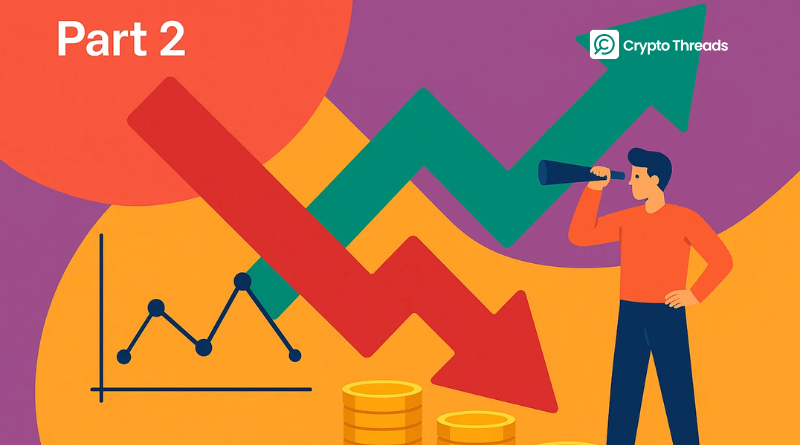Portfolio Management (Part 2): Understanding Risk and Return
In Part 1, we laid the groundwork, discussing what constitutes an investment portfolio, why diversification is such a vital ally, and the basics of assembling an asset mix tailored to your needs. For those just joining, we likened a portfolio to a curated collection of financial instruments—stocks, bonds, perhaps even a dash of cryptocurrency—all selected to help achieve specific financial objectives. Now, in Part 2, our focus shifts to two fundamental concepts that underpin every investment decision: risk and return. Consider these twin engines propelling your investment journey; grasping them is akin to learning the rules of the road before you start driving.
Consider this guide your compass for navigating the inevitable fluctuations of investing. We’ll explore methods for measuring your investment returns, delve into the critical balance between risk and reward, contrast various popular investment vehicles, and guide you in selecting assets that align with your personal comfort level. Ultimately, you’ll be better prepared to make informed choices, striking a balance between aspirations for financial growth and the inherent uncertainties of the market. Let’s dive in!
What are Investment Returns?
Investment return, frequently shortened to just “return,” quantifies the profit or loss an investment yields compared to the initial capital invested. This is usually shown as a percentage. Two widely recognized metrics for measuring returns are Return on Investment (ROI) and Compound Annual Growth Rate (CAGR).
Return on Investment (ROI)
Return on Investment (ROI) is a foundational profitability metric. It gauges the return generated from a specific investment in relation to its initial cost. Notable features of ROI are its straightforward calculation and its wide-ranging applicability across different kinds of investments.
The calculation itself is quite direct:
Where:
- Net Profit = Current Value of Investment – Cost of Investment
For example, if an individual invests $1,000 in a stock and sells it a year later for $1,200:
- The net profit is: $1,200 − $1,000 = $200.
- The ROI would be:
Compound Annual Growth Rate (CAGR)
The Compound Annual Growth Rate (CAGR) is a particularly useful tool for assessing an investment’s performance over periods exceeding one year. It reflects the average annual growth rate an investment achieves during a specific timeframe, under the assumption that any profits are reinvested. A key characteristic of CAGR is its capacity to offer a smoothed, annualized rate of return. This makes it simpler to compare different investments, especially those with varying time horizons or performance that fluctuates year to year.
CAGR is calculated using the formula:
Where:
- Vf: Final value
- Vi: Initial value
- n: Number of years
For instance, if an initial investment of $1,000 grows to $1,500 over three years, the CAGR would be:
or 14.47%
CAGR provides a more accurate picture of annual growth than a simple average, especially for investments with fluctuating returns.
The Inescapable Risk-Return Tradeoff
A cornerstone of investing is the Risk-Return Tradeoff. This fundamental principle posits that higher potential returns usually come hand-in-hand with increased levels of risk. Conversely, investments characterized by lower risk tend to offer more modest potential returns. This concept is pivotal in portfolio management, as it forces investors to determine the amount of risk they are comfortable undertaking in their quest for desired returns.
It’s crucial to remember: a “risk-free” high return is generally a myth. If an investment opportunity promises remarkably high returns with what appears to be minimal risk, it should be approached with considerable caution. A solid grasp of this tradeoff empowers investors to establish realistic expectations and construct a portfolio that harmonizes with their personal risk tolerance and financial aspirations. The objective isn’t to eliminate risk altogether—as that would also mean forgoing potential returns—but rather to manage it judiciously.
Comparing Investment Products: A Risk-Return Spectrum
Various investment products occupy different positions on the risk-return spectrum. Knowing where common asset classes typically land on this spectrum is beneficial when aiming to build a well-diversified portfolio.
Bank Savings Accounts
- Risk Level: Very Low. Typically, deposits are insured by government entities (like the FDIC in the United States) up to specified amounts. The main concern here is inflation risk – the possibility that interest earned won’t outpace rising prices, thereby diminishing your purchasing power over time.
- Return Potential: Very Low. Interest rates on savings accounts are generally modest, frequently just keeping pace with, or sometimes falling short of, the inflation rate.
- Characteristics: Offers high liquidity and focuses on capital preservation. Ideal for emergency funds or objectives with very short timelines.
Stocks (Equities)
- Risk Level: Medium to High. Stock prices are known for their potential volatility, reacting to factors such as company-specific performance, broader industry trends, prevailing economic conditions, and overall market sentiment. It’s possible for investors to lose part or even all of their invested capital.
- Return Potential: Medium to High. Historically, equities have demonstrated the capacity for higher long-term returns when compared to assets with lower risk profiles, fueled by company growth and the distribution of dividends.
- Characteristics: Provides potential for both capital appreciation and income from dividends. Well-suited for long-term growth goals, but necessitates a greater tolerance for risk.
Cryptocurrencies
- Risk Level: Very High. Cryptocurrencies represent a relatively new and highly speculative asset class. They are marked by extreme price fluctuations, evolving regulatory landscapes, inherent security concerns (such as hacking and scams), and various technological risks.
- Return Potential: Very High. Much of the appeal of cryptocurrencies stems from their potential for exponential growth, as evidenced by the past performance of well-known assets like Bitcoin and Ethereum. Nevertheless, the prospect of substantial losses is just as significant.
- Characteristics: Often decentralized, exhibit high volatility, and operate on blockchain technology. These are generally appropriate only for investors possessing a very high tolerance for risk and a solid understanding of the underlying technology and market dynamics. Financial advisors commonly recommend allocating only a small fraction of one’s overall portfolio to such speculative assets.
Application: Matching Investments to Your Risk Tolerance
Risk tolerance refers to an individual’s personal capacity and emotional willingness to endure potential losses within their investment portfolio. Understanding this is a critical element in making sound asset allocation decisions.
Conservative Investors
Individuals in this category place a higher priority on preserving their capital than on chasing high returns. They generally feel uneasy with notable swings in their portfolio’s value.
- Characteristics: Typically have a low tolerance for risk. Often, these are individuals approaching retirement or those with financial goals set for the near future.
- Suitable Investments: Their portfolios are often dominated by bank savings accounts, certificates of deposit (CDs), government bonds, and investment-grade corporate bonds. A modest portion might be allocated to low-volatility dividend-paying stocks or conservative mutual funds.
Moderate Investors
Moderate investors aim for a judicious balance between risk and potential reward. They are generally prepared to accept a degree of market volatility in pursuit of returns that could potentially surpass more conservative options.
- Characteristics: Possess a medium risk tolerance and frequently have a medium to long-term investment outlook.
- Suitable Investments: A well-rounded portfolio is typical, often including a mix of stocks (encompassing both growth and value strategies), bonds, and possibly some exposure to real estate (for example, through REITs) or diversified investment funds like Exchange Traded Funds (ETFs).
Aggressive Investors
These investors are typically willing to embrace considerable risk with the prospect of achieving substantial returns. They often have a long investment horizon and the capacity to weather significant market downturns.
- Characteristics: Exhibit a high tolerance for risk. This group often includes younger investors or individuals with ample capital who can absorb potential losses without derailing their long-term financial plans.
- Suitable Investments: Their portfolios usually feature a larger allocation to stocks, particularly growth stocks and small-cap stocks. They might also include alternative investments such as cryptocurrencies, private equity, or venture capital. Bonds may constitute a smaller portion of their portfolio, primarily for diversification purposes.
To gain further insights into evaluating your own risk profile, resources such as the Investor Questionnaire provided by the SEC can be quite helpful.
Conclusion: Balancing Risk and Reward for Portfolio Success
Grasping the dynamics of risk and return extends beyond mere theory; it forms the practical bedrock of successful portfolio management. By clearly understanding return metrics such as ROI and CAGR, appreciating the unwavering nature of the risk-return tradeoff, and carefully comparing the attributes of various investment products, individuals can make more strategically sound decisions. Crucially, aligning investment choices with one’s personal risk tolerance ensures that a portfolio not only strives towards financial objectives but also fosters a sense of confidence and peace of mind in the investment process. Remember, the journey of portfolio management is an ongoing one, necessitating continuous evaluation of both risk and return as market conditions and personal situations evolve.



